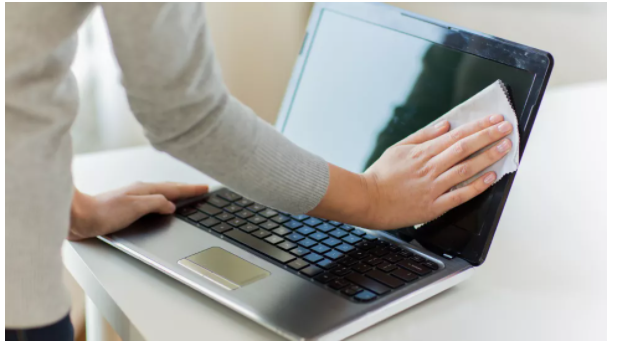Give your home office a fresh start

Your laptop screen is not only an invaluable window into the online world, but also a magnet for all kinds of particles and detritus – ranging from ancient food stains caused by wayward spaghetti bolognese flicks to dust and invisible microbes and bacteria.
With the novel coronavirus having recently been found to survive on certain surfaces for several days, it’s more crucial than ever to clean your laptop screen properly.
LCD laptop screens are very sensitive, with many of them lacking the layer of protection that glass screens on old CRT monitors used to have. So do not use glass cleaner, window cleaner, or other harsh products on your screen.
Some screens – such as certain MacBook displays and touchscreens – have an oleophobic layer, which offers some protection against fingerprints and smudges, but can wear off if you use alcohol-based cleaners.
That’s not to say that you shouldn’t use alcohol-based cleaners on any laptop screen however. If killing off germs is your main concern then isopropyl cleaner is fine to use on non-oleophobic screens (usually touchscreens). Isopropyl is quite mild as alcohol-based solvents go, and widely used for its antibacterial and antiviral properties.
You can use 99% isopropyl, but if you’re feeling cautious about it being too strong, you can just as well use 75% or gentler stuff instead. In fact, isopropyl diluted down as far as 60% with purified water can even be more effective than 99.9% isopropyl, because the water makes the solution better at permeating microorganism cell walls and slows the solvent’s evaporation time, increasing the time it spends in contact with the microorganism.
Do not spray your screen cleaner directly onto your laptop screen. Instead, spray or dab the cleaner onto a microfiber cloth, then from there gently wipe it onto your laptop screen in small circular motions or from one end to the other. Do not drench your cloth in the cleaning solution, just dampen it.
As we’ll cover in other tech-cleaning guides, isopropyl can be used on just about any surface you may want to disinfect.
Isopropyl is an effective germ-killer, but doesn’t have any anti-static or specifically anti-streak properties that dedicated screen cleaners contain. So after (or instead of) wiping your laptop screen with isopropyl, you should use a non-alcoholic screen cleaner to finish the job.
Gently rub the cloth around your laptop screen, making sure you do not press down too hard.
Ecomoist and WHOOSH! are two of the more popular laptop screen cleaners, though there’ll be plenty of similar ones out there that probably work just as well. They’re alcohol-free, biodegradable, and their anti-static formulation will keep those dust particles off your screen for a bit longer.
We also think it’s a nice touch that Ecomoist bottles are designed to be refilled, and you can actually buy refills directly from Ecomoist so that you’re using the same spray bottle over and over again.

